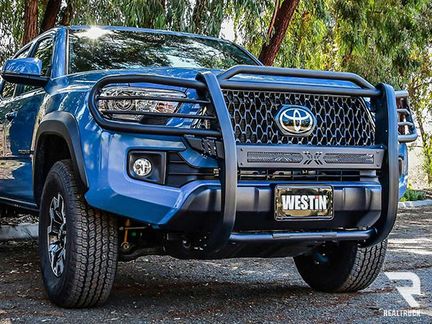The Half Safe: How an Amphibious Jeep Traveled the World
Updated on Jul 18, 2023
Imagine, for a moment, being tasked with circumnavigating the globe. You’d likely select multiple vehicles to accomplish the trek, ranging from a Jeep Grand Cherokee to an aircraft and sea-going vessels; however, what if you could only choose one? While a plane may seem the most logical option, it certainly wasn’t for Australia-native Frederick "Ben" Carlin.
You see, as an engineer in the Indian Army Corp of Engineers in World War II, Carlin found himself surrounded by the latest and greatest military machinery. Upon a routine inspection, he laid eyes upon the Ford GPA–a small amphibious vehicle based on Ford’s WWII-era Jeep, the GPW. Unbeknownst to Carlin at the time, he’d later modify a similar vehicle for a seven-year-long journey around the globe.
This is the story of the Half Safe: Frederick Carlin’s mad science project that took him Westward from Nova Scotia to Montreal.
The Ford GPW and GPA Jeep
While most know the WWII-era Jeep as the Willys MB, which looks similar to the Wrangler TJ today, only half of all Jeeps from the second world war were manufactured by Willys; the other half were built by Ford based on Willys' design. These Ford "Jeeps" were designated the GPW, which breaks down as “G” for “Government,” “P” for “80-inch wheelbase reconnaissance,” and “W” for “Willys.”
During this time, Ford also produced an amphibious vehicle based on the GPW chassis, this time earning the designation "GPA." This sea-going counterpart retained the G and P nomenclature but ditched the W for an “amphibious” A.
While not successful in combat, considering the GPA’s slow land speeds and inability to cross tumultuous seas, nearly 13,000 amphibious vehicles were manufactured during the war. And though approximately half were shipped to the Soviet Union, several wound up back in Army surplus stores, where Carlin purchased the unsuspecting "Seep" (sea-Jeep) that’d eventually become the Half Safe.
The Half Safe
At the close of the Second World War, Ben Carlin acquired a surplus GPA for a measly $901. Almost immediately, he began adapting, modifying, and equipping the chassis for his monumental trek.
The body was extended by several feet to accommodate a larger 200-gallon fuel tank, allowing the modified GPA to travel far greater distances without refueling. An enclosed cabin grafted onto the GPA’s boat-like body formed the sleeping and living quarters.
Though pressing along, Carlin was often labeled a fool by his peers, and can you blame them? Even his attempts to secure a sponsorship from Ford Motor Company, the manufacturer of the GPA, were met with skepticism and negativity. Only a maniac with a death wish would brave treacherous oceans in such a dangerous vehicle.
The vessel eventually earned its nickname from its cobbled-together appearance; the Half Safe hardly looked fit to float, let alone sail around the world!
After a handful of failed launches and mechanical failures, including a broken exhaust that leaked carbon monoxide into the “living quarters,” Ben Carlin set sail from Nova Scotia with his wife, Elinore.
Around the World in…7 Years
The two ventured Westward across the Atlantic, prime with 30 days of supplies and an ample supply of fuel towed behind the Half Safe in floating containers. Though Carlin had expanded the GPA’s fuel supply, the vessel still required routine fillings, which consisted of anchoring the Half Safe, dragging the fuel containers to the hull, and siphoning fuel into the in-board tank.
Well into the second half of the journey, Carlin’s wife became overcome with exhaustion and sea sickness. Fearful that the trip may be her last, she chose to abandon ship, while the pair was passing through Australia on a fund-raising tour in 1956. Ben Carlin pressed forward, accompanied by anyone who dared climb aboard the crude vessel.
Directly after his wife’s abandonment, a fellow Australian joined him for 5 months. Afterward, an American journalist stayed with Carlin for nearly a year, beginning in 1957 until the Half Safe rolled into Anchorage, Alaska in late 1957. The writer profiled many of his Half Safe experiences in a book entitled, Once a Fool: From Tokyo to Alaska by Amphibious Jeep.
A Miraculous Return
After seven years and ten months, Carlin and the Half Safe returned to Montreal, Canada, in May 1958. Unbelievably, Carlin and his creation covered 38,987 miles over land and another 11,000 at sea, earning him the title of the first and only individual to circumnavigate the globe in an amphibious vehicle.
Legacy
To this day, not a soul has been able to claim such a feat, making Carlin’s journey the stuff of legend. Unfortunately, the journey did little but fuel Carlin’s critics, tarnish his marriage, and deplete his bank account. While the tale of the Half Safe is rarely told, the legendary vessel still exists today. After Carlin’s death in 1981, the Half Safe was purchased and displayed by his childhood school, Guildford Grammar, where it remains today.
If Ben Carlin taught us anything, it’s the power of persistence. If one can forego their perceptions of what is realistically attainable long enough to believe that anything is possible, they can achieve greatness.
Shop Now
RealTruck is your home for the best products to outfit your build for unforgettable adventures.
Consoles and Organizers | Automotive Lighting | Lift Kits | Wheels and Rims
See More Guide Articles Here...
- …
Join over 2 million RealTruck people
Get exclusive savings, insider information, and the latest RealTruck articles sent straight to your inbox.



